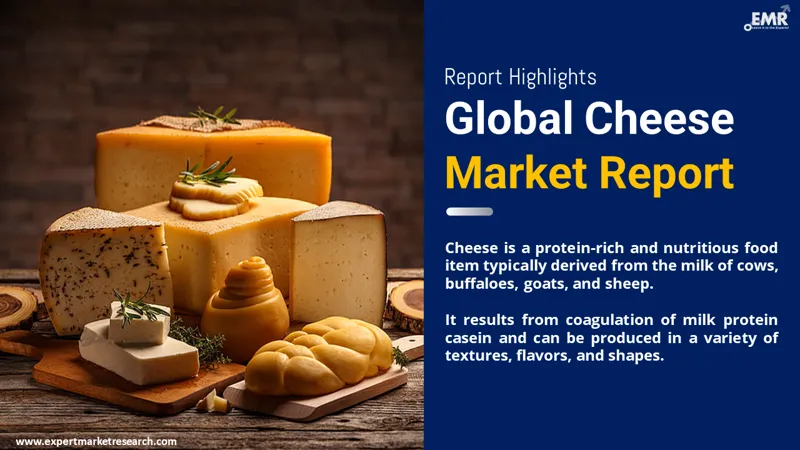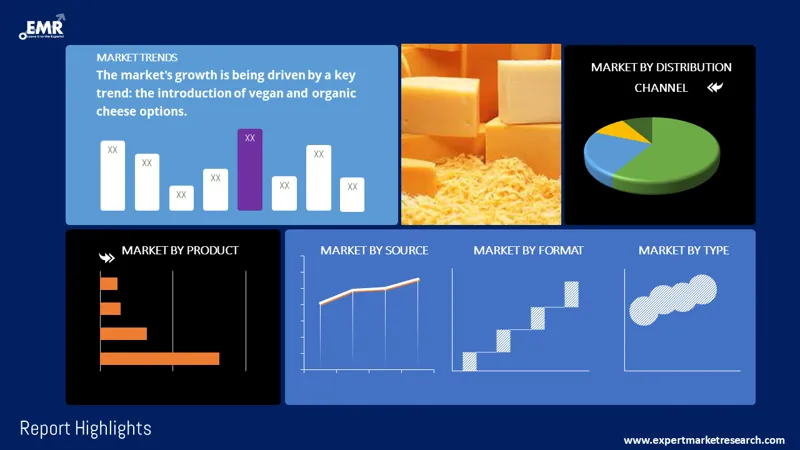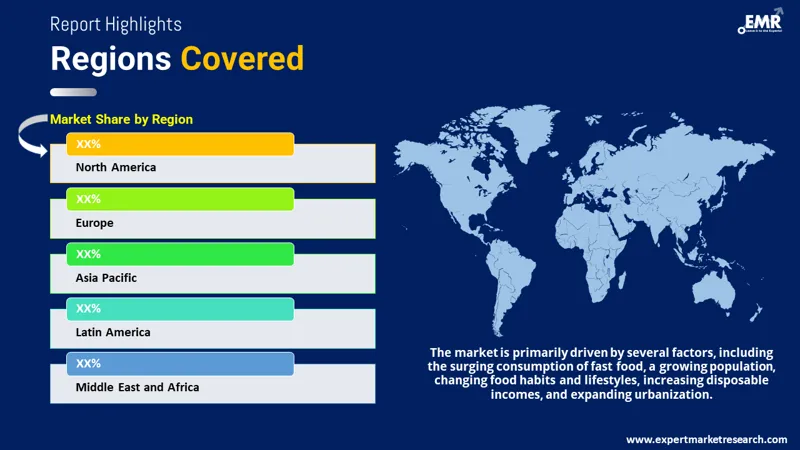Reports
Sale

Global Cheese Market Size, Share, Trends, Growth, Forecast: By Source: Cow Milk, Buffalo Milk, Goat Milk, Others; By Type: Natural, Processed; By Product: Mozzarella, Cheddar, Feta, Parmesan, Roquefort, Others; By Distribution Channel: Supermarkets and Hypermarkets, Others; By Format; Regional Analysis; Competitive Landscape; 2024-2032
Global Cheese Market Outlook
The global cheese market size reached a value of about USD 94.70 billion in 2023. The market is further expected to grow at a CAGR of 7.8% in the forecast period of 2024-2032 to reach a value of approximately USD 186.19 billion by 2032.
Cheese is a healthy and high-protein food product usually made from the milk of cows, buffaloes, goats and sheep. It is formed by the coagulation of the milk protein casein and can be prepared in a wide range of flavours, textures and forms.
This report by EMR provides a comprehensive analysis for anyone who plans to foray into the cheese market. The market is currently being driven by a high demand for dairy products and growing demand from the fast-food market where the product is a key ingredient. Other factors like changing lifestyles and food habits, growing urbanisation, and increasing disposable incomes in emerging economies are also bolstering the growth of the global market. On a regional level, Europe currently represents the largest cheese market.

Read more about this report - REQUEST FREE SAMPLE COPY IN PDF
Cheese Market Segmentation
Based on the source, the market is categorised into:
- Cow Milk
- Buffalo Milk
- Goat Milk
- Others
The demand for cows milk cheese in the global market remains robust, as cows milk is the most widely used milk source for cheese production. This segment encompasses a vast range of cheese types, each with its unique characteristics and consumer base. Cows milk is used to produce a wide array of cheeses, from soft, fresh cheeses like Mozzarella and Brie to hard, aged varieties like Cheddar and Parmigiano-Reggiano.
Cheese is a staple in many Western diets and is increasingly being incorporated into culinary traditions worldwide. Cows milk cheese, in particular, is often preferred for its familiar taste and wide availability. The processed food sector, including frozen meals, snacks, and ready-to-eat products, heavily utilises cow's milk cheese, contributing to its consistent demand.
On the basis of type, the market is divided into:
- Natural
- Processed
Natural cheese occupies a significant cheese market share. The demand for natural cheese in the market is substantial and continues to grow, driven by consumer preferences for authenticity, quality, and flavour. Natural cheese refers to cheese that is made directly from milk and is minimally processed, without the addition of artificial preservatives, colours, or flavours.
As consumers become more health-conscious, there is an increasing preference for natural and wholesome foods. Natural cheese is often viewed as a healthier option due to its minimal processing and absence of artificial additives. Furthermore, consumers are willing to pay a premium for natural cheeses that offer unique flavours, origins, and artisanal qualities.

Read more about this report - REQUEST FREE SAMPLE COPY IN PDF
Based on product, the market has been segmented as
- Mozzarella
- Cheddar
- Feta
- Parmesan
- Roquefort
- Others
Mozzarella cheese, renowned for its mild flavour and excellent melting qualities, holds a significant position in the global market. Its demand is influenced by various factors, ranging from culinary trends to its versatile applications. Mozzarellas’ quintessential role in pizzas, a staple in fast food and casual dining, greatly drives the demand of the mozzarella cheese market. Its melting characteristics and neutral taste make it ideal for a wide array of pizza styles.
Beyond pizza, Mozzarella is used in various dishes like lasagna, salads (like Caprese), sandwiches, and appetisers. Its versatility across different cuisines contributes to its widespread popularity. The growth in the ready-to-eat and convenience food sectors, where Mozzarella is often used in frozen meals, pre-made snacks, and meal kits, also boosts cheese market demand.
On the basis of distribution channels, the market is divided into:
- Supermarkets and Hypermarkets
- Convenience Stores
- Specialty Stores
- Online
- Others
Based on the various distribution channels, supermarkets and hypermarkets represent the biggest point of sales for the product. Supermarkets and hypermarkets offer an extensive range of cheese products, from basic, everyday options to gourmet and specialty cheeses and this variety caters to a broad spectrum of consumer preferences and budgets.
These retail giants often engage in promotional activities, including discounts, tasting events, and pairing recommendations, which can influence consumer purchasing decisions and drive sales. In-store displays, information labels, and knowledgeable staff can educate consumers about different types of cheese, their origins, and uses, which can encourage the exploration and trial of new varieties. Many supermarkets and hypermarkets have introduced their private label cheese products, offering quality cheese at competitive prices and these private labels can often compete with established cheese brands.
Based on format, the market can be segmented into:
- Slices
- Diced/Cubes
- Shredded
- Blocks
- Spreads
- Liquid
- Others
The slices segment in the market refers to pre-sliced cheese products, which are widely popular due to their convenience and ease of use. Pre-sliced cheese offers significant convenience, especially for busy consumers or those seeking quick meal preparation options as it eliminates the need for slicing and portioning, saving time and effort. Sliced cheese provides uniform portions, which is particularly useful for consistent sandwich making, cooking, and baking.
In supermarkets and grocery stores, sliced cheese is popular among individual consumers and families for home use, often used in sandwiches, burgers, and quick snacks. The food service sector, including restaurants, cafés, and fast-food outlets, frequently utilises pre-sliced cheese for efficiency and consistency in meal preparation.

Read more about this report - REQUEST FREE SAMPLE COPY IN PDF
The report also covers the major regional markets for cheese, which are as follows:
- North America
- Europe
- Asia Pacific
- Latin America
- Middle East and Africa
Cheese Market Analysis
Cheese contains a host of nutrients like calcium, protein, phosphorus, zinc, vitamin A and vitamin B12, which makes it a nutritional food for all age groups. The growing demand for cheese in the preparation of fast foods is driving the global cheese market growth.
The value chain analysis of the product has also been covered in this report encompassing all the activities in the value chain such as procurement, manufacturing, sales and distribution.
This report provides an exhaustive insight for setting up and running a cheese manufacturing plant. Factors such as land requirement, construction requirement, raw material requirement, labour requirement, machinery requirement, manufacturing process, utility requirement, total capital investment, total operating costs, prices, income projections, expenditure projections, profit margins, net present value, return on investment, payback period, etc. have been comprehensively covered in this report.
Regional Insights
The Europe cheese market is one of the largest and most diverse in the world, characterised by a deep-rooted cheese-making tradition and a wide variety of local and regional specialities. Europe has a rich history of cheese-making with numerous regions having their traditional cheese and this tradition plays a key role in the high consumption and demand for cheese.
The strong preference for artisanal, locally produced cheeses, in the region, which are perceived to be of higher quality and more authentic, is one of the crucial cheese market trends. Despite a love for cheese, there is also a growing health consciousness among European consumers, leading to increased demand for organic, low-fat, and reduced-sodium cheese varieties in Europe.
Competitive Landscape
The report gives a detailed analysis of the following key players in the global market, covering their competitive landscape, capacity, and latest developments like mergers, acquisitions, and investments, expansions of capacity, and plant turnarounds:
- Nestle SA
- Danone S.A.
- Dean Foods Co.
- Lactalis International
- Fonterra Co-operative Group
- Royal FrieslandCampina N.V.
- Arla Foods amba
- Others
The comprehensive EMR report provides an in-depth assessment of the global cheese market based on the Porter's five forces model along with giving a SWOT analysis.
Key Highlights of the Report
| REPORT FEATURES | DETAILS |
| Base Year | 2023 |
| Historical Period | 2018-2023 |
| Forecast Period | 2024-2032 |
| Scope of the Report |
Historical and Forecast Trends, Industry Drivers and Constraints, Historical and Forecast Market Analysis by Segment:
|
| Breakup by Source |
|
| Breakup by Type |
|
| Breakup by Product |
|
| Breakup by Distribution Channel |
|
| Breakup by Format |
|
| Breakup by Region |
|
| Market Dynamics |
|
| Competitive Landscape |
|
| Companies Covered |
|
*At Expert Market Research, we strive to always give you current and accurate information. The numbers depicted in the description are indicative and may differ from the actual numbers in the final EMR report.
1 Preface
2 Report Coverage – Key Segmentation and Scope
3 Report Description
3.1 Market Definition and Outlook
3.2 Properties and Applications
3.3 Market Analysis
3.4 Key Players
4 Key Assumptions
5 Executive Summary
5.1 Overview
5.2 Key Drivers
5.3 Key Developments
5.4 Competitive Structure
5.5 Key Industrial Trends
6 Snapshot
6.1 Global
6.2 Regional
7 Opportunities and Challenges in the Market
8 Global Cheese Market Analysis
8.1 Key Industry Highlights
8.2 Global Cheese Historical Market (2018-2023)
8.3 Global Cheese Market Forecast (2024-2032)
8.4 Global Cheese Market by Source
8.4.1 Cow Milk
8.4.1.1 Historical Trend (2018-2023)
8.4.1.2 Forecast Trend (2024-2032)
8.4.2 Buffalo Milk
8.4.2.1 Historical Trend (2018-2023)
8.4.2.2 Forecast Trend (2024-2032)
8.4.3 Goat Milk
8.4.3.1 Historical Trend (2018-2023)
8.4.3.2 Forecast Trend (2024-2032)
8.4.4 Others
8.5 Global Cheese Market by Type
8.5.1 Natural
8.5.1.1 Historical Trend (2018-2023)
8.5.1.2 Forecast Trend (2024-2032)
8.5.2 Processed
8.5.2.1 Historical Trend (2018-2023)
8.5.2.2 Forecast Trend (2024-2032)
8.6 Global Cheese Market by Product
8.6.1 Mozzarella
8.6.1.1 Historical Trend (2018-2023)
8.6.1.2 Forecast Trend (2024-2032)
8.6.2 Cheddar
8.6.2.1 Historical Trend (2018-2023)
8.6.2.2 Forecast Trend (2024-2032)
8.6.3 Feta
8.6.3.1 Historical Trend (2018-2023)
8.6.3.2 Forecast Trend (2024-2032)
8.6.4 Parmesan
8.6.4.1 Historical Trend (2018-2023)
8.6.4.2 Forecast Trend (2024-2032)
8.6.5 Roquefort
8.6.5.1 Historical Trend (2018-2023)
8.6.5.2 Forecast Trend (2024-2032)
8.6.6 Others
8.7 Global Cheese Market by Distribution Channel
8.7.1 Supermarkets and Hypermarkets
8.7.1.1 Historical Trend (2018-2023)
8.7.1.2 Forecast Trend (2024-2032)
8.7.2 Convenience Stores
8.7.2.1 Historical Trend (2018-2023)
8.7.2.2 Forecast Trend (2024-2032)
8.7.3 Specialty Stores
8.7.3.1 Historical Trend (2018-2023)
8.7.3.2 Forecast Trend (2024-2032)
8.7.4 Online
8.7.4.1 Historical Trend (2018-2023)
8.7.4.2 Forecast Trend (2024-2032)
8.7.5 Others
8.8 Global Cheese Market by Format
8.8.1 Slices
8.8.1.1 Historical Trend (2018-2023)
8.8.1.2 Forecast Trend (2024-2032)
8.8.2 Diced/Cubes
8.8.2.1 Historical Trend (2018-2023)
8.8.2.2 Forecast Trend (2024-2032)
8.8.3 Shredded
8.8.3.1 Historical Trend (2018-2023)
8.8.3.2 Forecast Trend (2024-2032)
8.8.4 Blocks
8.8.4.1 Historical Trend (2018-2023)
8.8.4.2 Forecast Trend (2024-2032)
8.8.5 Spreads
8.8.5.1 Historical Trend (2018-2023)
8.8.5.2 Forecast Trend (2024-2032)
8.8.6 Liquid
8.8.6.1 Historical Trend (2018-2023)
8.8.6.2 Forecast Trend (2024-2032)
8.8.7 Others
8.9 Global Cheese Market by Region
8.9.1 North America
8.9.1.1 Historical Trend (2018-2023)
8.9.1.2 Forecast Trend (2024-2032)
8.9.2 Europe
8.9.2.1 Historical Trend (2018-2023)
8.9.2.2 Forecast Trend (2024-2032)
8.9.3 Asia Pacific
8.9.3.1 Historical Trend (2018-2023)
8.9.3.2 Forecast Trend (2024-2032)
8.9.4 Latin America
8.9.4.1 Historical Trend (2018-2023)
8.9.4.2 Forecast Trend (2024-2032)
8.9.5 Middle East and Africa
8.9.5.1 Historical Trend (2018-2023)
8.9.5.2 Forecast Trend (2024-2032)
9 North America Cheese Market Analysis
9.1 United States of America
9.1.1 Historical Trend (2018-2023)
9.1.2 Forecast Trend (2024-2032)
9.2 Canada
9.2.1 Historical Trend (2018-2023)
9.2.2 Forecast Trend (2024-2032)
10 Europe Cheese Market Analysis
10.1 United Kingdom
10.1.1 Historical Trend (2018-2023)
10.1.2 Forecast Trend (2024-2032)
10.2 Germany
10.2.1 Historical Trend (2018-2023)
10.2.2 Forecast Trend (2024-2032)
10.3 France
10.3.1 Historical Trend (2018-2023)
10.3.2 Forecast Trend (2024-2032)
10.4 Italy
10.4.1 Historical Trend (2018-2023)
10.4.2 Forecast Trend (2024-2032)
10.5 Others
11 Asia Pacific Cheese Market Analysis
11.1 China
11.1.1 Historical Trend (2018-2023)
11.1.2 Forecast Trend (2024-2032)
11.2 Japan
11.2.1 Historical Trend (2018-2023)
11.2.2 Forecast Trend (2024-2032)
11.3 India
11.3.1 Historical Trend (2018-2023)
11.3.2 Forecast Trend (2024-2032)
11.4 ASEAN
11.4.1 Historical Trend (2018-2023)
11.4.2 Forecast Trend (2024-2032)
11.5 Australia
11.5.1 Historical Trend (2018-2023)
11.5.2 Forecast Trend (2024-2032)
11.6 Others
12 Latin America Cheese Market Analysis
12.1 Brazil
12.1.1 Historical Trend (2018-2023)
12.1.2 Forecast Trend (2024-2032)
12.2 Argentina
12.2.1 Historical Trend (2018-2023)
12.2.2 Forecast Trend (2024-2032)
12.3 Mexico
12.3.1 Historical Trend (2018-2023)
12.3.2 Forecast Trend (2024-2032)
12.4 Others
13 Middle East and Africa Cheese Market Analysis
13.1 Saudi Arabia
13.1.1 Historical Trend (2018-2023)
13.1.2 Forecast Trend (2024-2032)
13.2 United Arab Emirates
13.2.1 Historical Trend (2018-2023)
13.2.2 Forecast Trend (2024-2032)
13.3 Nigeria
13.3.1 Historical Trend (2018-2023)
13.3.2 Forecast Trend (2024-2032)
13.4 South Africa
13.4.1 Historical Trend (2018-2023)
13.4.2 Forecast Trend (2024-2032)
13.5 Others
14 Market Dynamics
14.1 SWOT Analysis
14.1.1 Strengths
14.1.2 Weaknesses
14.1.3 Opportunities
14.1.4 Threats
14.2 Porter’s Five Forces Analysis
14.2.1 Supplier’s Power
14.2.2 Buyer’s Power
14.2.3 Threat of New Entrants
14.2.4 Degree of Rivalry
14.2.5 Threat of Substitutes
14.3 Key Indicators for Demand
14.4 Key Indicators for Price
15 Value Chain Analysis
16 Price Analysis
16.1 North America Historical Price Trends (2018-2023) and Forecast (2024-2032)
16.2 Europe Historical Price Trends (2018-2023) and Forecast (2024-2032)
16.3 Asia Pacific Historical Price Trends (2018-2023) and Forecast (2024-2032)
16.4 Latin America Historical Price Trends (2018-2023) and Forecast (2024-2032)
16.5 Middle East and Africa Historical Price Trends (2018-2023) and Forecast (2024-2032)
17 Manufacturing Process
17.1 Detailed Process Flow
17.2 Operations Involved
17.3 Mass Balance
18 Project Requirement and Cost Analysis
18.1 Land, Location, and Site Development
18.2 Construction
18.3 Plant Machinery
18.4 Cost of Raw Material
18.5 Packaging
18.6 Transportation
18.7 Utilities
18.8 Manpower
18.9 Other Capital Investment
19 Project Economics
19.1 Capital Cost of the Project
19.2 Techno-Economic Parameters
19.3 Product Pricing and Margins Across Various Levels of the Supply Chain
19.4 Taxation and Depreciation
19.5 Income Projections
19.6 Expenditure Projections
19.7 Financial Analysis
19.8 Profit Analysis
20 Competitive Landscape
20.1 Market Structure
20.2 Company Profiles
20.3.1 Nestle SA
20.3.1.1 Company Overview
20.3.1.2 Product Portfolio
20.3.1.3 Demographic Reach and Achievements
20.3.1.4 Certifications
20.3.2 Danone S.A.
20.3.2.1 Company Overview
20.3.2.2 Product Portfolio
20.3.2.3 Demographic Reach and Achievements
20.3.2.4 Certifications
20.3.3 Dean Foods Co.
20.3.3.1 Company Overview
20.3.3.2 Product Portfolio
20.3.3.3 Demographic Reach and Achievements
20.3.3.4 Certifications
20.3.4 Lactalis International
20.3.4.1 Company Overview
20.3.4.2 Product Portfolio
20.3.4.3 Demographic Reach and Achievements
20.3.4.4 Certifications
20.3.5 Fonterra Co-operative Group
20.3.5.1 Company Overview
20.3.5.2 Product Portfolio
20.3.5.3 Demographic Reach and Achievements
20.3.5.4 Certifications
20.3.6 Royal FrieslandCampina N.V.
20.3.6.1 Company Overview
20.3.6.2 Product Portfolio
20.3.6.3 Demographic Reach and Achievements
20.3.6.4 Certifications
20.3.7 Arla Foods amba
20.3.7.1 Company Overview
20.3.7.2 Product Portfolio
20.3.7.3 Demographic Reach and Achievements
20.3.7.4 Certifications
20.3.8 Others
21 Key Trends and Developments in the Market
List of Key Figures and Tables
1. Global Cheese Market: Key Industry Highlights, 2018 and 2032
2. Global Cheese Historical Market: Breakup by Source (USD Billion), 2018-2023
3. Global Cheese Market Forecast: Breakup by Source (USD Billion), 2024-2032
4. Global Cheese Historical Market: Breakup by Type (USD Billion), 2018-2023
5. Global Cheese Market Forecast: Breakup by Type (USD Billion), 2024-2032
6. Global Cheese Historical Market: Breakup by Product (USD Billion), 2018-2023
7. Global Cheese Market Forecast: Breakup by Product (USD Billion), 2024-2032
8. Global Cheese Historical Market: Breakup by Distribution Channel (USD Billion), 2018-2023
9. Global Cheese Market Forecast: Breakup by Distribution Channel (USD Billion), 2024-2032
10. Global Cheese Historical Market: Breakup by Format (USD Billion), 2018-2023
11. Global Cheese Market Forecast: Breakup by Format (USD Billion), 2024-2032
12. Global Cheese Historical Market: Breakup by Region (USD Billion), 2018-2023
13. Global Cheese Market Forecast: Breakup by Region (USD Billion), 2024-2032
14. North America Cheese Historical Market: Breakup by Country (USD Billion), 2018-2023
15. North America Cheese Market Forecast: Breakup by Country (USD Billion), 2024-2032
16. Europe Cheese Historical Market: Breakup by Country (USD Billion), 2018-2023
17. Europe Cheese Market Forecast: Breakup by Country (USD Billion), 2024-2032
18. Asia Pacific Cheese Historical Market: Breakup by Country (USD Billion), 2018-2023
19. Asia Pacific Cheese Market Forecast: Breakup by Country (USD Billion), 2024-2032
20. Latin America Cheese Historical Market: Breakup by Country (USD Billion), 2018-2023
21. Latin America Cheese Market Forecast: Breakup by Country (USD Billion), 2024-2032
22. Middle East and Africa Cheese Historical Market: Breakup by Country (USD Billion), 2018-2023
23. Middle East and Africa Cheese Market Forecast: Breakup by Country (USD Billion), 2024-2032
24. North America Historical Price Trends and Forecast 2018-2028
25. Europe Historical Price Trends and Forecast 2018-2028
26. Asia Pacific Historical Price Trends and Forecast 2018-2028
27. Latin America Historical Price Trends and Forecast 2018-2028
28. Middle East and Africa Historical Price Trends and Forecast 2018-2028
29. Global Cheese Market Structure
In 2023, the global cheese market attained a value of nearly USD 94.70 billion.
The market is projected to grow at a CAGR of 7.8% between 2024 and 2032.
The market is estimated to witness a healthy growth in the forecast period of 2024-2032 to reach about USD 186.19 billion by 2032.
The major drivers of the market include the growing consumption of fast food, increasing population, changing lifestyles and food habits, rising disposable incomes, and the growing urbanisation.
The key trend aiding the growth of the market include the launch of vegan and organic cheese variants.
The major regional markets are North America, Europe, the Asia Pacific, Latin America and the Middle East and Africa, with Europe accounting for the largest market share.
Cow milk, buffalo milk, and goat milk, among others are the major source types in the market.
Natural and processed are the major cheese types available in the market.
The major product types available in the market are mozzarella, cheddar, feta, parmesan, Roquefort, and others.
Slices, diced/cubes, shredded, blocks, spreads, and liquid, among others, are the major segments in the industry based on product format.
Supermarkets and hypermarkets represent the leading distribution channels of the product.
The major players in the market are Nestle SA, Danone S.A., Dean Foods Co., Lactalis International, Fonterra Co-operative Group, Royal FrieslandCampina N.V., and Arla Foods amba, among others.
Mini Report
-
Selected Sections, One User
-
Printing Not Allowed
-
Email Delivery in PDF
-
Free Limited Customisation -
Post Sales Analyst Support -
50% Discount on Next Update
Single User License
-
All Sections, One User
-
One Print Allowed
-
Email Delivery in PDF
-
Free Limited Customisation -
Post Sales Analyst Support -
50% Discount on Next Update

Five User License
-
All Sections, Five Users
-
Five Prints Allowed
-
Email Delivery in PDF
-
Free Limited Customisation
-
Post Sales Analyst Support
-
50% Discount on Next Update
Corporate License
-
All Sections, Unlimited Users
-
Unlimited Prints Allowed
-
Email Delivery in PDF + Excel
-
Free Limited Customisation
-
Post Sales Analyst Support
-
50% Discount on Next Update
Any Question? Speak With An Analyst
View A Sample
Did You Miss Anything, Ask Now
Right People
We are technically excellent, strategic, practical, experienced and efficient; our analysts are hand-picked based on having the right attributes to work successfully and execute projects based on your expectations.
Right Methodology
We leverage our cutting-edge technology, our access to trusted databases, and our knowledge of the current models used in the market to deliver you research solutions that are tailored to your needs and put you ahead of the curve.
Right Price
We deliver in-depth and superior quality research in prices that are reasonable, unmatchable, and shows our understanding of your resource structure. We, additionally, offer attractive discounts on our upcoming reports.
Right Support
Our team of expert analysts are at your beck and call to deliver you optimum results that are customised to meet your precise needs within the specified timeframe and help you form a better understanding of the industry.


